When you’re looking to elevate your indoor garden, variegated houseplants offer an unmatched visual impact with their stunning leaf patterns. From the prayer-like movements of Maranta leuconeura to the bold pink speckles of Aglaonema, these natural works of art transform ordinary spaces into botanical showcases. You’ll discover how each variety brings its own mix of colors, patterns, and growing requirements to create your perfect indoor jungle.
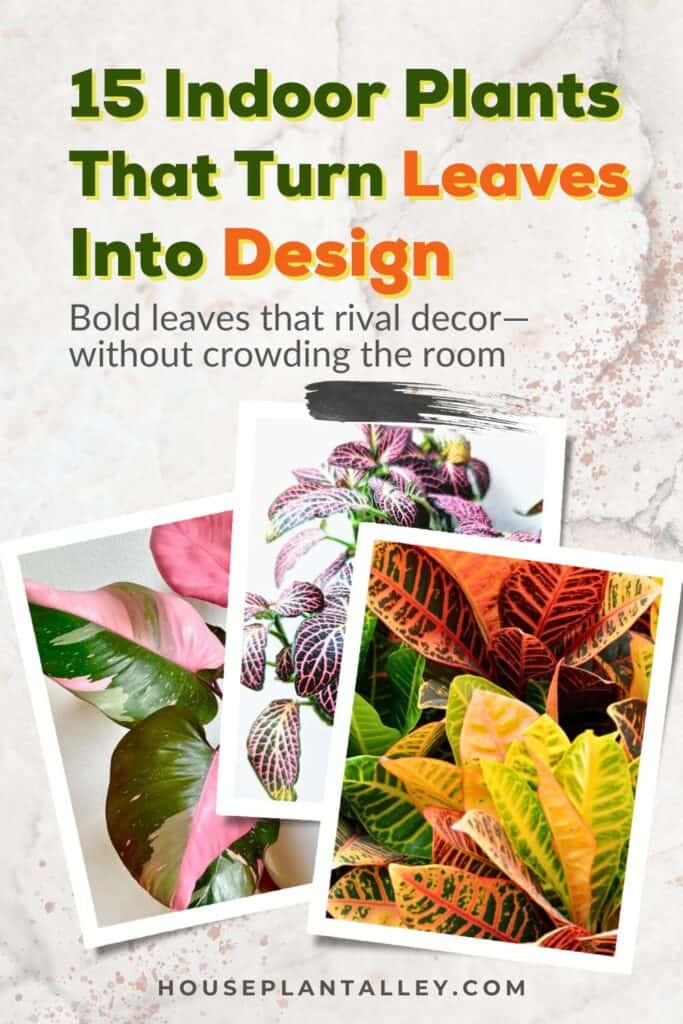
Contents
- 1 1. The Striking Prayer Plant
- 2 2. Pink-Spotted Chinese Evergreen
- 3 3. Speckled Nerve Plant
- 4 4. Spotted Swiss Cheese Plant
- 5 5. Silver-Striped Calathea Ornata
- 6 6. Persian Shield
- 7 7. Golden Pothos’s Heart-Shaped Leaves
- 8 8. Silvery-Striped Snake Plant
- 9 9. Purple-Edged English Ivy
- 10 10. Zebra-striped Tradescantia
- 11 11. Marbled Pink Philodendron
- 12 12. Rainbow-Leaf Croton
- 13 13. Polka-dot Syngonium
- 14 14. White-Streaked Spider Plant
- 15 15. Green-Speckled Rubber Plant
1. The Striking Prayer Plant
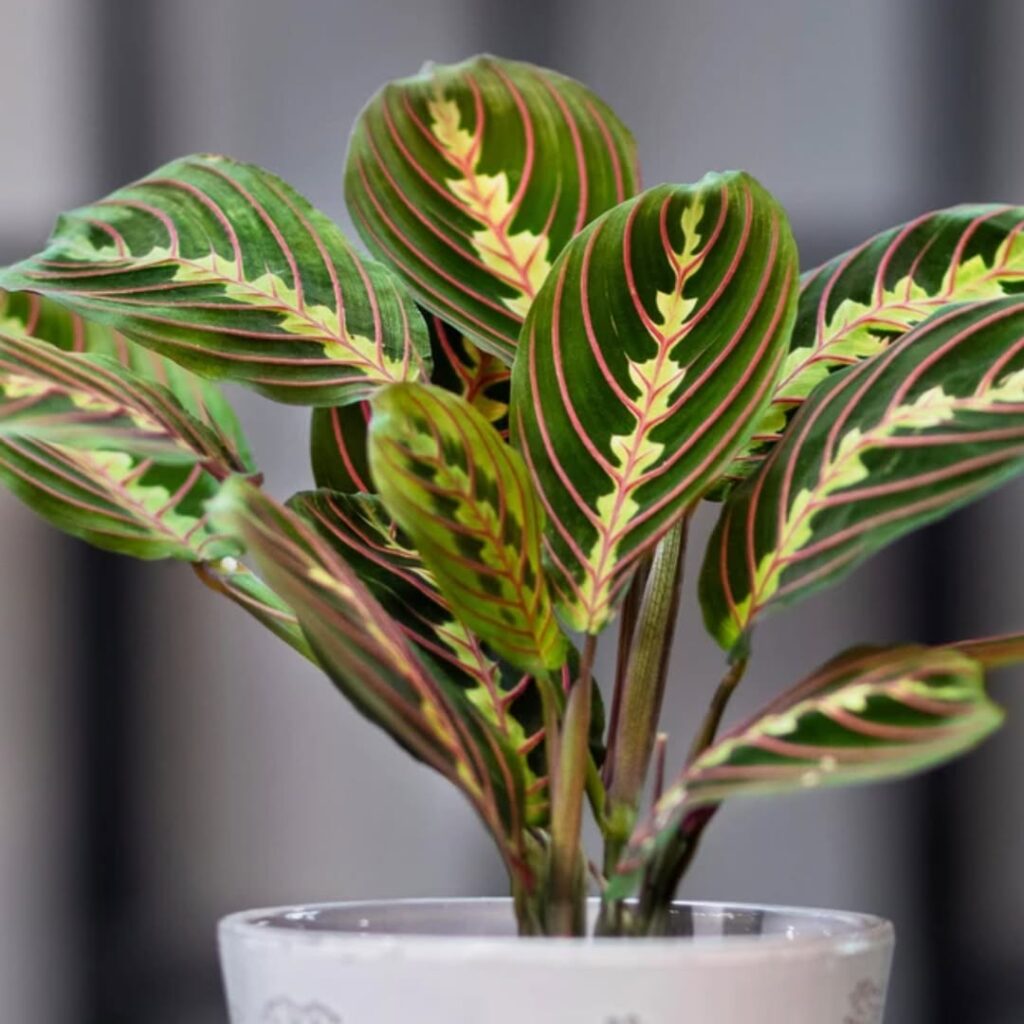
The Prayer Plant (Maranta leuconeura) is a stunning tropical houseplant known for its distinctive variegated foliage featuring intricate patterns of dark green, light green, and red veins on oval-shaped leaves. Its name comes from the unique daily movement of its leaves, which fold upward at night like hands in prayer and lower during the day to catch more light. The most common variety displays a fishbone-like pattern, while other cultivars showcase different variegation styles.
- Light: Bright, indirect light; avoid direct sunlight which can fade variegation
- Water: Keep soil consistently moist but not waterlogged; water when top inch of soil feels dry
- Humidity: High humidity (60% or higher); use pebble tray or humidifier
- Temperature: 65-80°F (18-27°C)
- Soil: Well-draining, rich potting mix with peat moss
- Fertilizer: Feed monthly with balanced liquid fertilizer during growing season
- Pot: Container with drainage holes to prevent root rot
2. Pink-Spotted Chinese Evergreen
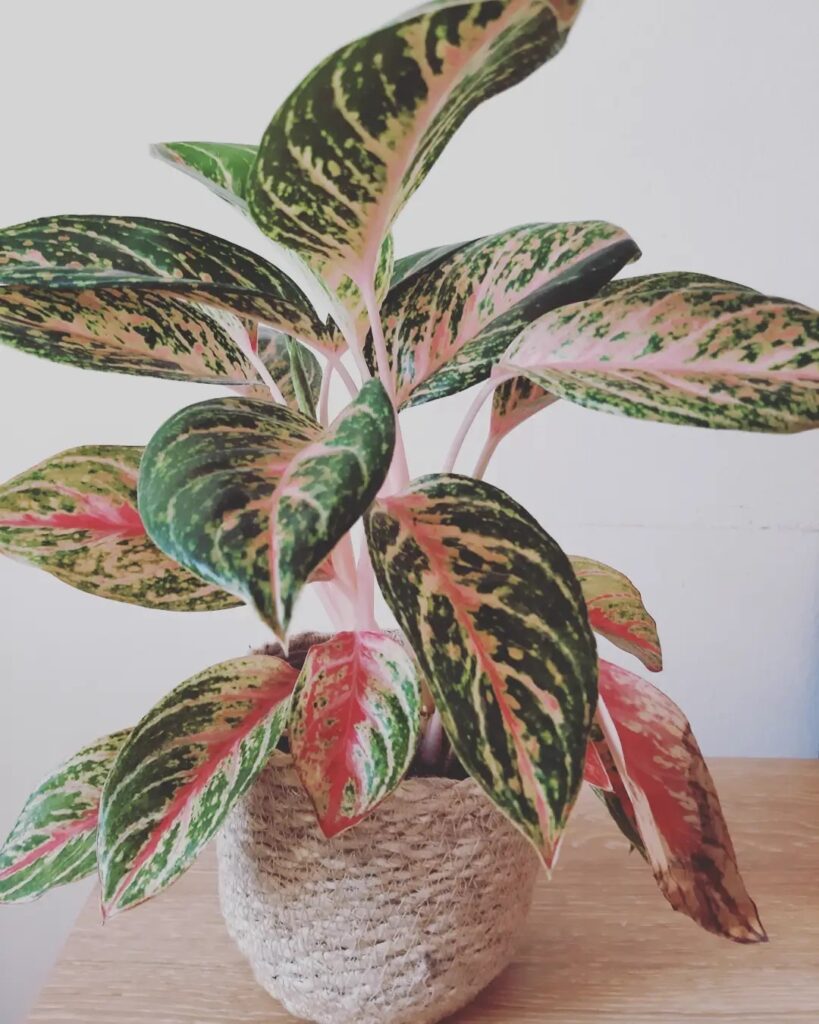
The Pink-Spotted Chinese Evergreen (Aglaonema ‘Pink Spot’) is a striking tropical houseplant known for its large, oval leaves adorned with pink speckles and splotches against a dark green background. This slow-growing variety reaches heights of 1-2 feet and produces clusters of small white flowers, though it’s primarily grown for its decorative foliage. As a member of the Aglaonema family, it’s valued for its air-purifying qualities and relatively low-maintenance nature, making it an excellent choice for both novice and experienced indoor gardeners.
- Light: Thrives in low to medium indirect light; avoid direct sunlight which can fade variegation
- Water: Keep soil consistently moist but not waterlogged; water when top 1-2 inches of soil feels dry
- Soil: Well-draining potting mix rich in organic matter
- Humidity: Prefers high humidity levels around 60%
- Temperature: Maintains best growth between 65-80°F (18-27°C)
- Fertilizer: Feed with balanced liquid fertilizer every 6-8 weeks during growing season
- Soil pH: Slightly acidic to neutral (6.0-7.0)
3. Speckled Nerve Plant

The Speckled Nerve Plant (Fittonia albivenis) is a compact, low-growing tropical plant known for its distinctive leaf patterns featuring white, pink, or red veins against deep green leaves. This creeping perennial forms dense mats of foliage and typically reaches only 3-6 inches in height, making it perfect for terrariums and small spaces. Native to South American rainforests, the nerve plant gets its common name from its pronounced leaf venation that creates an intricate network across each leaf’s surface.
- Light: Bright indirect light; avoid direct sunlight which can scorch leaves
- Water: Keep soil consistently moist but not waterlogged; prefers high humidity
- Soil: Well-draining, rich potting mix with added peat moss
- Temperature: 60-80°F (16-27°C)
- Humidity: Minimum 50%; higher humidity preferred
- Fertilizer: Feed monthly with balanced liquid fertilizer during growing season
- Pruning: Trim regularly to maintain shape and promote bushier growth
- Propagation: Easily propagated through stem cuttings in water or soil
4. Spotted Swiss Cheese Plant
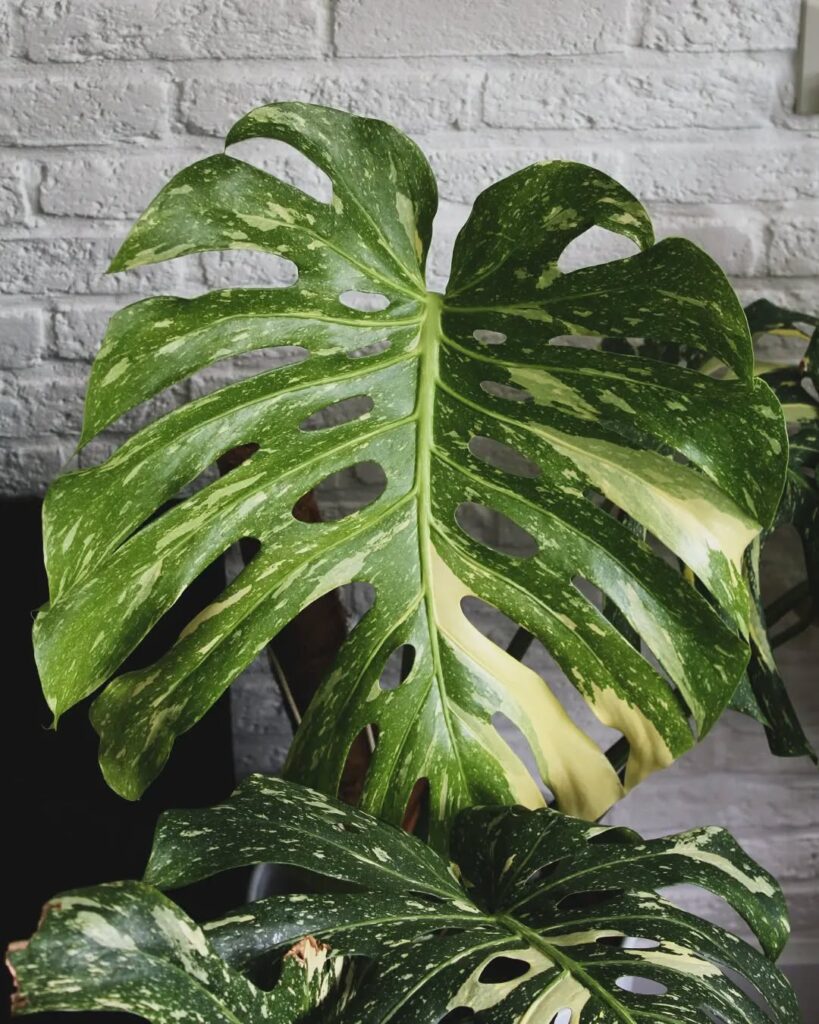
The Spotted Swiss Cheese Plant (Monstera deliciosa ‘Thai Constellation’) is a stunning variegated cultivar of the classic Monstera deliciosa, featuring cream-colored speckles and splashes across its large, fenestrated leaves. Unlike the random variegation patterns of other Monstera varieties, the Thai Constellation’s markings are stable and genetically engineered, ensuring each new leaf maintains the distinctive spotting pattern. This highly sought-after houseplant can grow quite large, with individual leaves reaching up to 3 feet in length when mature.
- Light: Bright, indirect light; avoid direct sunlight which can burn variegated portions
- Water: Allow top 2-3 inches of soil to dry between waterings; reduce watering in winter
- Soil: Well-draining, chunky aroid mix with orchid bark, perlite, and peat moss
- Humidity: High humidity (60-80%); benefits from regular misting or humidifier
- Temperature: 65-85°F (18-29°C); protect from cold drafts
- Fertilizer: Monthly feeding during growing season with balanced liquid fertilizer
- Support: Requires moss pole or trellis for climbing as it matures
5. Silver-Striped Calathea Ornata
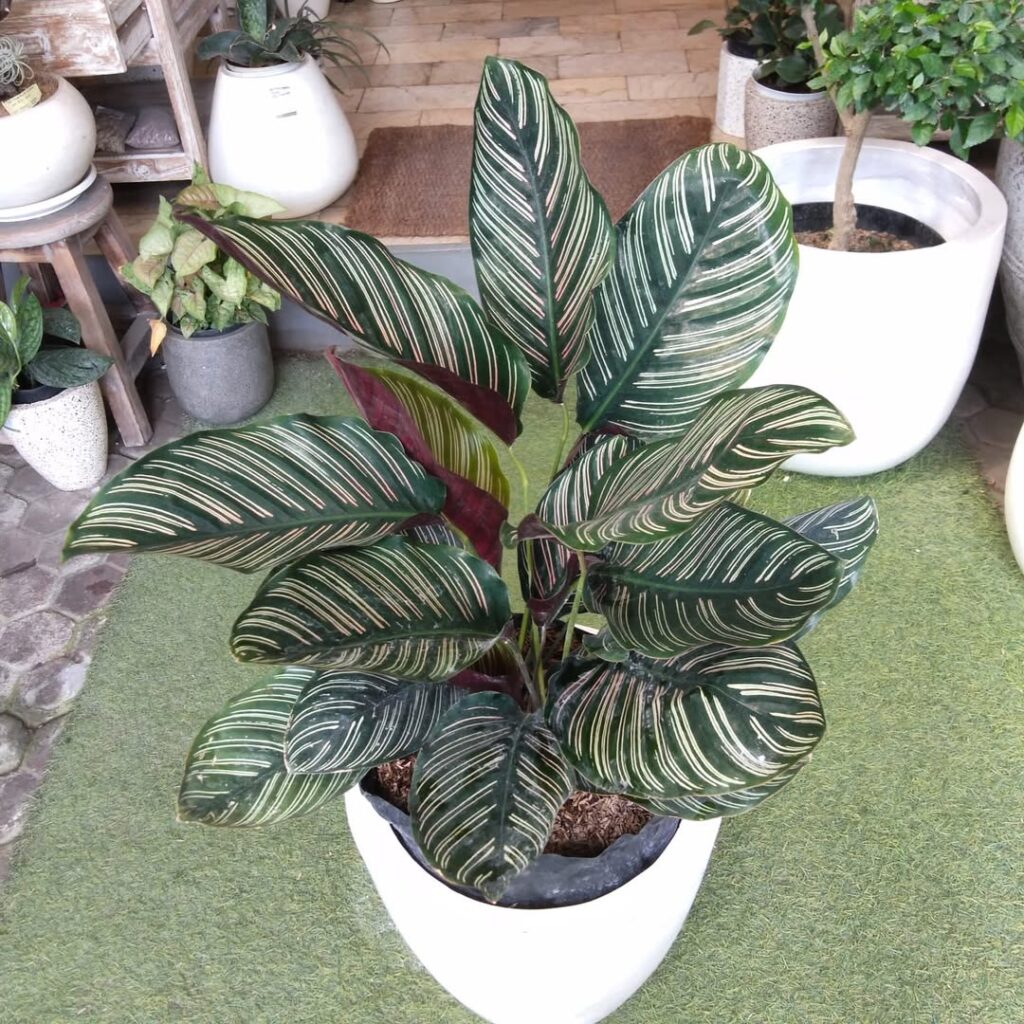
The Silver-Striped Calathea Ornata is a striking tropical plant known for its distinctive pink or white pinstripes that contrast beautifully against dark green leaves. These oval-shaped leaves grow on long stems and can reach up to 2 feet in height. The plant exhibits nyctinasty, a natural phenomenon where leaves fold up at night and unfurl in the morning, earning it the nickname “prayer plant.” Native to South America, this eye-catching houseplant adds an elegant touch to indoor spaces while purifying the air.
- Light: Bright indirect light; avoid direct sunlight which can fade variegation and burn leaves
- Water: Keep soil consistently moist but not waterlogged; water when top inch of soil feels dry
- Humidity: High humidity (60% or higher); use humidifier or pebble tray
- Temperature: 65-80°F (18-27°C)
- Soil: Well-draining, rich potting mix with peat moss
- Fertilizer: Feed monthly with balanced liquid fertilizer during growing season
- Container: Pot with drainage holes to prevent root rot
- Additional Care: Regular misting and protection from cold drafts
6. Persian Shield
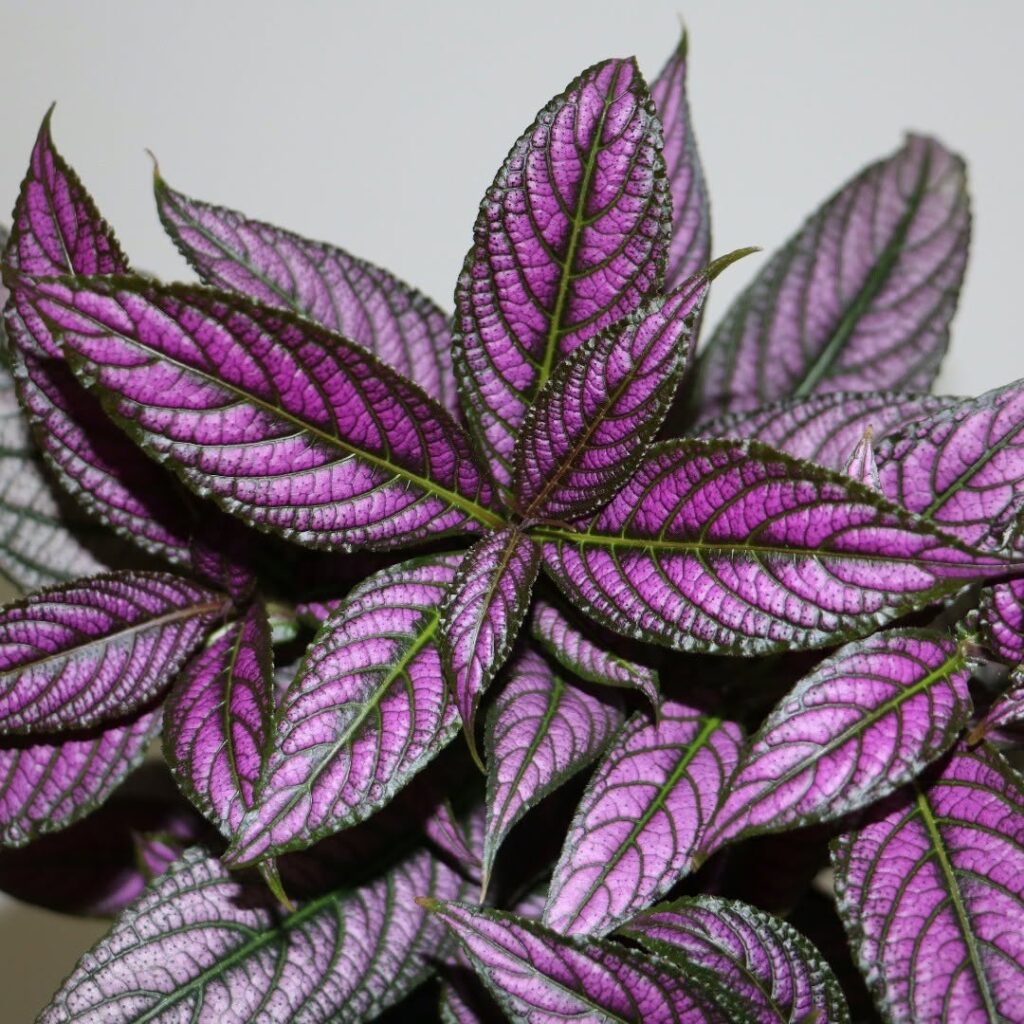
The Persian Shield (Strobilanthes dyerianus) features stunning iridescent purple foliage with a striking metallic sheen. This tropical plant, native to Myanmar, grows as an upright, bushy perennial reaching heights of 3-4 feet. The dramatic leaf patterns intensify when grown in proper lighting conditions, making it an enchanting addition to indoor plant collections and shaded outdoor gardens in warm climates.
- Light: Bright, indirect light; protect from direct sun which can fade leaves; tolerates partial shade
- Water: Keep soil consistently moist but not waterlogged; water when top inch of soil feels dry
- Soil: Rich, well-draining potting mix with high organic matter
- Humidity: Prefers high humidity levels; mist regularly or use a humidity tray
- Temperature: 60-75°F (15-24°C); not cold hardy
- Fertilizer: Feed monthly during growing season with balanced liquid fertilizer
- Pruning: Pinch back stems regularly to encourage bushier growth
7. Golden Pothos’s Heart-Shaped Leaves
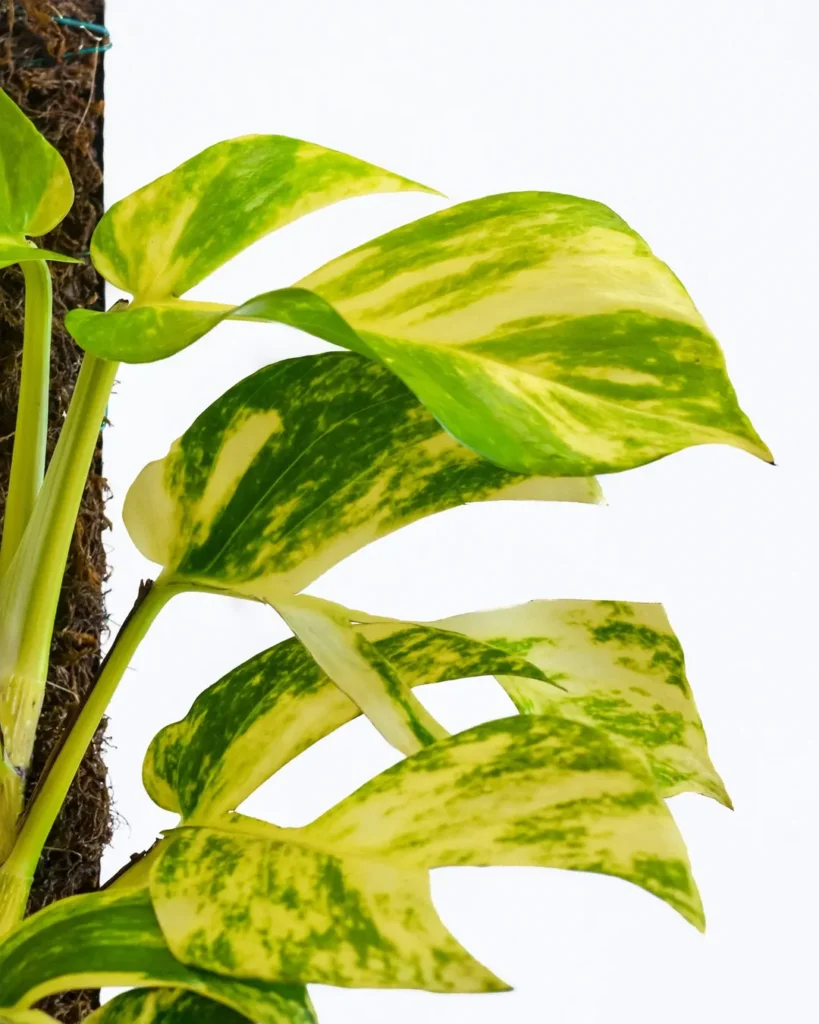
Golden Pothos features distinctive heart-shaped leaves with splashes of creamy yellow or white variegation against a deep green background. These trailing vines display leaves that can grow 4-8 inches long in prime conditions, though they typically remain smaller indoors. The variegation pattern varies from leaf to leaf, creating a naturally artistic display that brightens any indoor space.
- Light: Bright, indirect light; can tolerate low light but may lose variegation
- Water: Allow top 1-2 inches of soil to dry between waterings; reduce watering in winter
- Soil: Well-draining potting mix with added perlite
- Humidity: Adaptable to average indoor humidity levels
- Temperature: 60-80°F (15-27°C)
- Fertilizer: Monthly feeding during growing season with balanced liquid fertilizer
- Pruning: Trim leggy vines to maintain shape and promote bushier growth
- Container: Any well-draining pot with drainage holes
8. Silvery-Striped Snake Plant
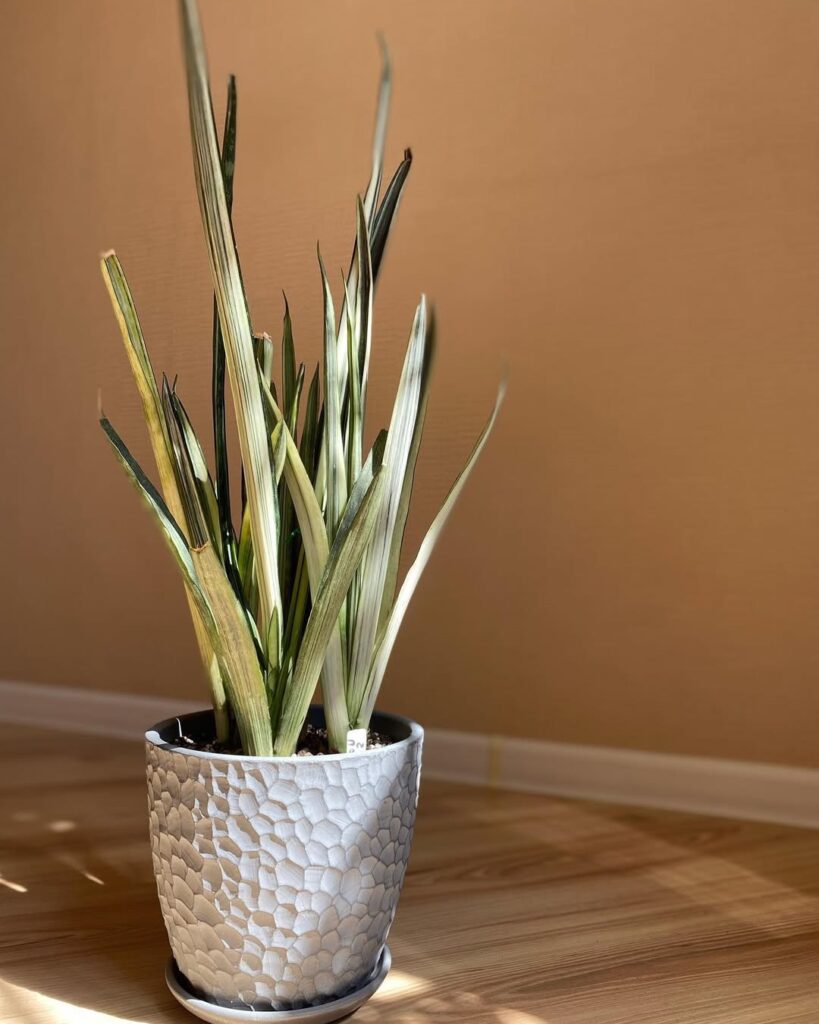
The Silvery-Striped Snake Plant (Sansevieria trifasciata ‘Bantel’s Sensation’) is a striking variety of snake plant featuring narrow, upright leaves with distinctive silvery-white vertical stripes running from base to tip. These elegant leaves grow in a tight, vertical pattern and can reach heights of 2-3 feet, making it an excellent architectural accent for any room. Unlike the common snake plant, this variegated cultivar displays more delicate striping patterns that appear almost painted on its dark green leaves.
- Light: Tolerates low to bright indirect light; avoid direct sunlight which can fade variegation
- Water: Allow soil to dry completely between waterings; water less frequently in winter
- Soil: Well-draining potting mix; preferably a cactus or succulent blend
- Humidity: Adapts to average indoor humidity levels
- Temperature: Thrives in 60-85°F (15-29°C)
- Fertilizer: Feed with balanced fertilizer once during growing season
- Pot Type: Container with drainage holes to prevent root rot
- Propagation: Division of rhizomes or leaf cuttings
9. Purple-Edged English Ivy
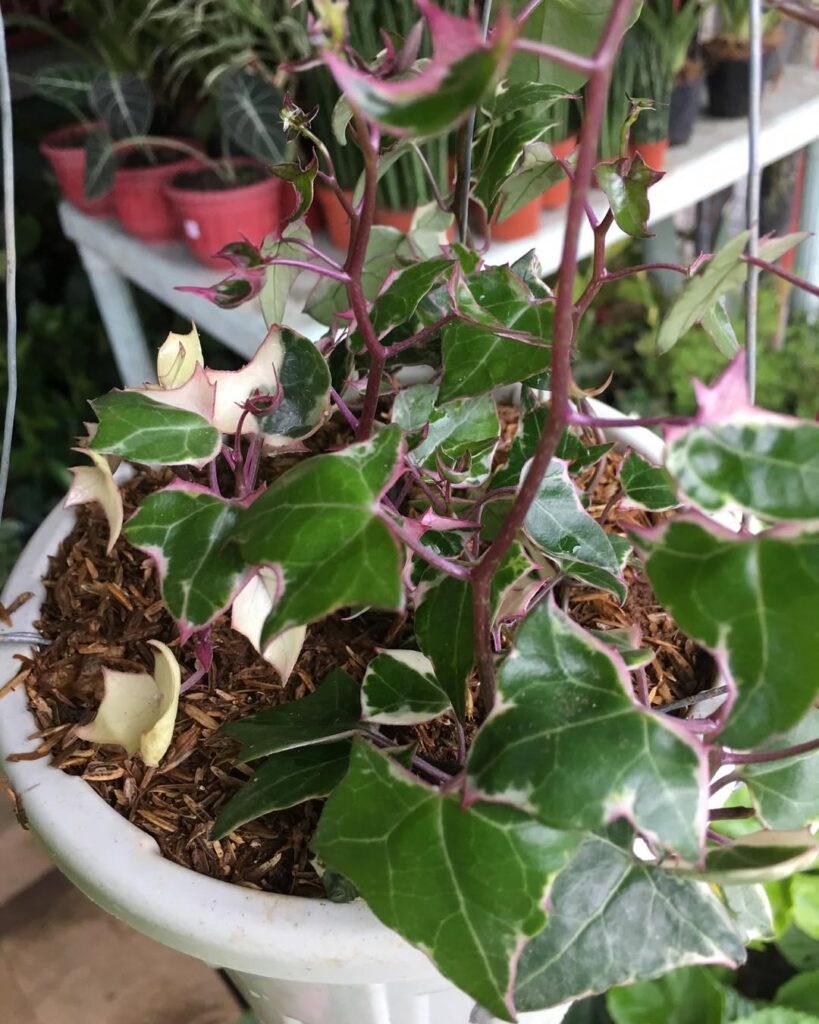
Purple-edged English Ivy, a striking cultivar of Hedera helix, features dark green leaves with distinctive purple-tinged margins that intensify in color during cooler months. This trailing vine creates an elegant display with its pointed, lobed leaves and can be grown as a hanging plant or trained to climb walls and trellises. The variegation adds visual interest and depth to indoor spaces, while the plant maintains the hardy nature typical of traditional English Ivy varieties.
- Light: Bright, indirect light; can tolerate partial shade but needs good light to maintain variegation
- Water: Keep soil consistently moist but not waterlogged; water when top inch of soil feels dry
- Soil: Well-draining, slightly acidic potting mix rich in organic matter
- Humidity: Moderate to high; benefits from regular misting
- Temperature: 60-75°F (15-24°C)
- Fertilizing: Feed with balanced liquid fertilizer every 2-4 weeks during growing season
- Pruning: Trim regularly to control growth and maintain shape
- Container: Use pot with drainage holes to prevent root rot
10. Zebra-striped Tradescantia
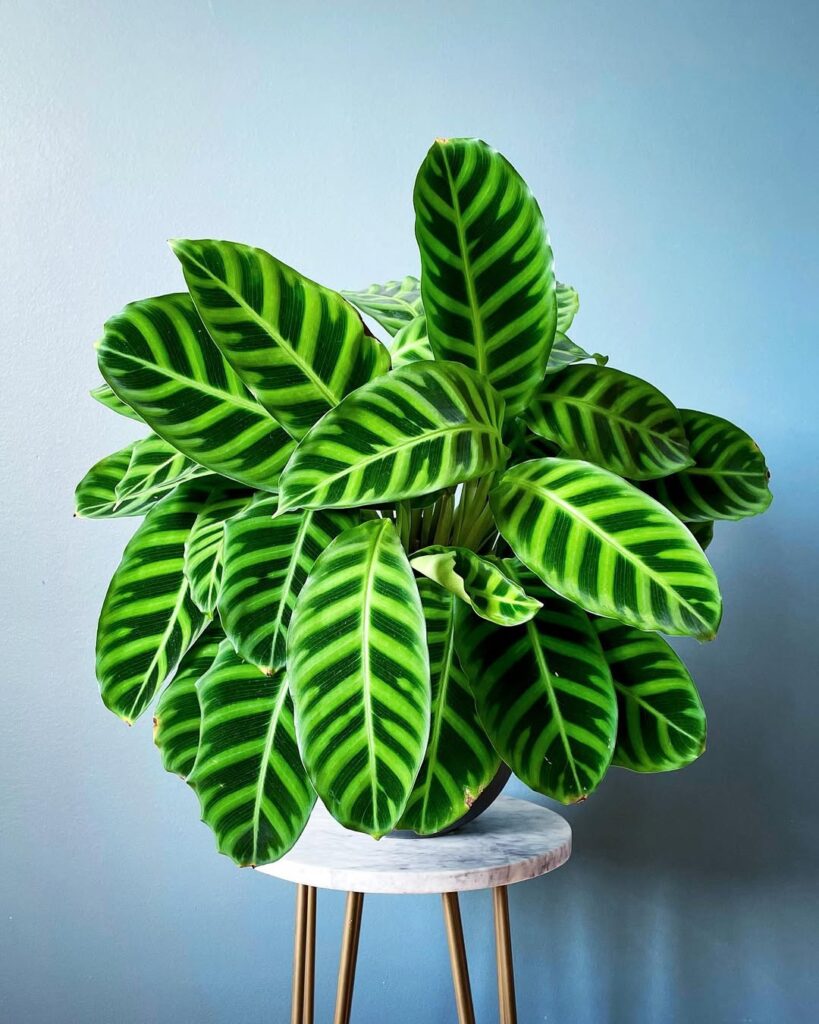
Tradescantia zebrina, commonly known as zebra-striped tradescantia or wandering jew, features striking variegated foliage with purple and silver stripes on the upper leaf surface and deep purple undersides. This trailing plant produces elongated, pointed leaves arranged alternately along purple stems that can grow up to 6-8 inches long. The bold striping pattern and easy-growing nature make it a popular choice for hanging baskets, window boxes, or as groundcover in frost-free climates.
- Light: Bright indirect light; can tolerate some direct morning sun but protect from harsh afternoon rays
- Water: Keep soil consistently moist but not waterlogged; water when top inch of soil feels dry
- Soil: Well-draining potting mix rich in organic matter
- Humidity: Thrives in moderate to high humidity; mist regularly in dry conditions
- Temperature: 60-80°F (15-27°C); not frost tolerant
- Fertilizer: Feed monthly during growing season with balanced liquid fertilizer
- Pruning: Trim regularly to maintain shape and promote bushier growth
11. Marbled Pink Philodendron
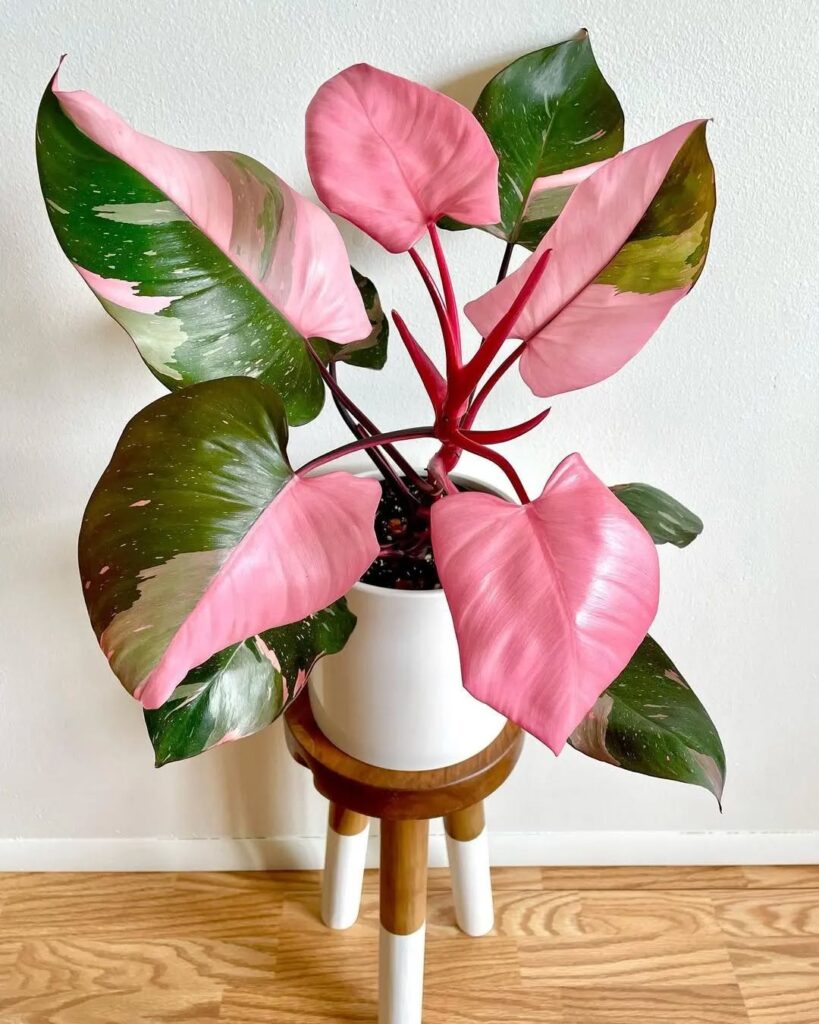
The Marbled Pink Philodendron is a stunning tropical plant known for its heart-shaped leaves featuring unique pink and white variegation patterns against deep green foliage. This rare variety of philodendron exhibits a marble-like appearance on its leaves, with each leaf displaying different amounts and patterns of pink coloring. The plant maintains a climbing or trailing growth habit, making it suitable for hanging baskets or climbing poles, while its stems can reach several feet in length when properly supported.
- Light: Bright, indirect sunlight; avoid direct sun which can burn leaves and fade variegation
- Water: Keep soil consistently moist but not waterlogged; water when top 1-2 inches of soil feels dry
- Soil: Well-draining, rich potting mix with added perlite and orchid bark
- Humidity: High humidity levels (60% or above)
- Temperature: 65-80°F (18-27°C)
- Fertilizer: Balanced liquid fertilizer monthly during growing season
- Support: Provide moss pole or trellis for climbing
- Pot: Container with drainage holes to prevent root rot
12. Rainbow-Leaf Croton
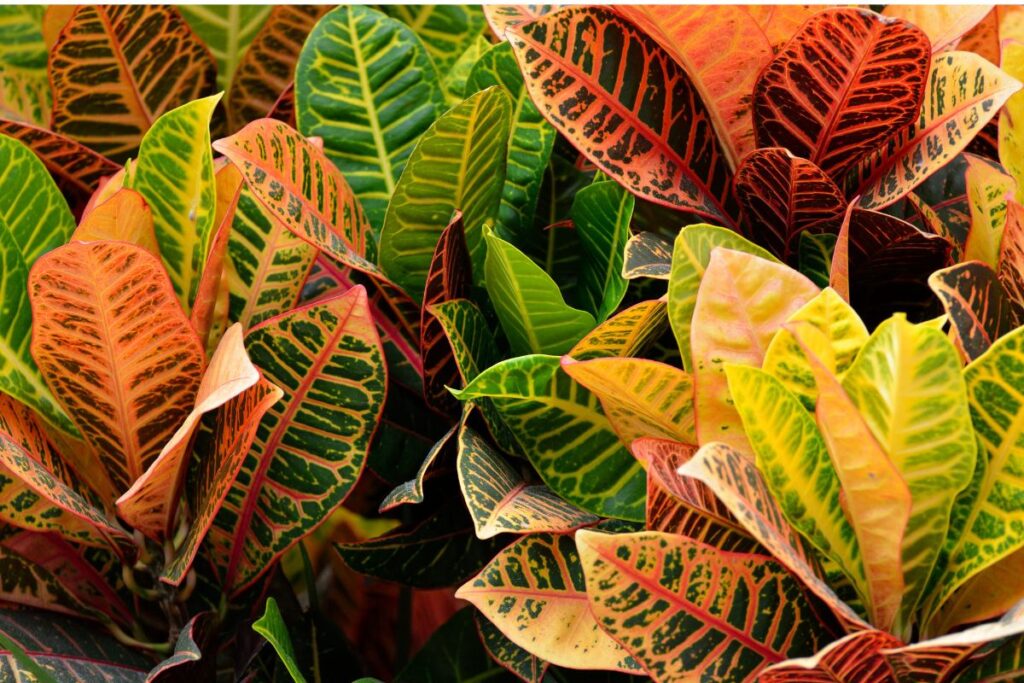
The Rainbow-Leaf Croton (Codiaeum variegatum) is a striking tropical plant known for its vibrant, multicolored foliage that can display combinations of green, yellow, orange, red, and purple. The leaves are typically oval or elongated with prominent veining, and their colors become more intense with increased light exposure. This ornamental plant can grow up to 6 feet tall indoors and makes a bold statement in any room, though it can be particular about its growing conditions.
- Light: Bright, indirect sunlight; morning sun is beneficial; protect from intense afternoon sun
- Water: Keep soil consistently moist but not waterlogged; water when top inch of soil feels dry
- Humidity: High humidity (50% or higher); regular misting or use of humidity tray recommended
- Temperature: 60-80°F (15-27°C); protect from cold drafts
- Soil: Well-draining, rich potting mix with added organic matter
- Fertilizer: Feed monthly during growing season with balanced, water-soluble fertilizer
- pH Level: 4.5-6.5 (slightly acidic)
13. Polka-dot Syngonium
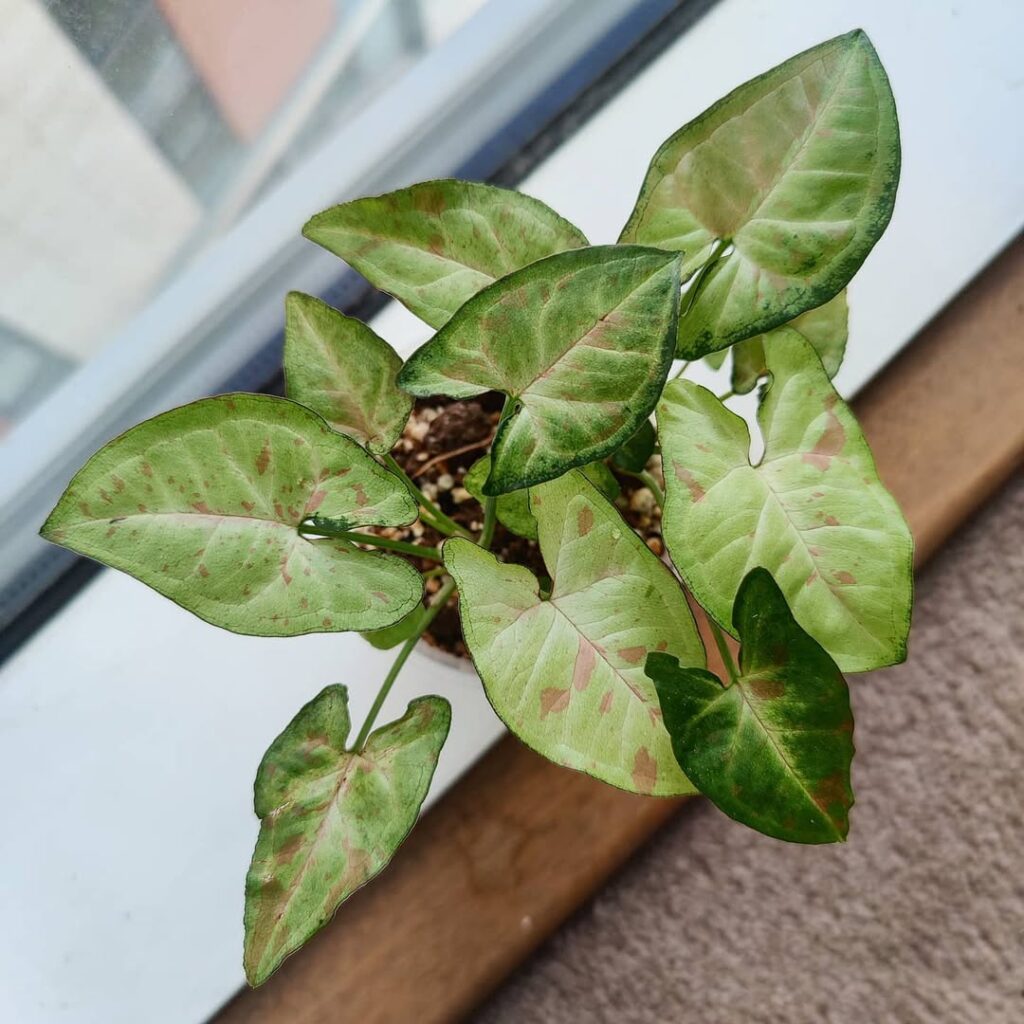
Polka-dot Syngonium (Syngonium podophyllum ‘Confetti’) is a striking tropical vine featuring arrow-shaped leaves splashed with pink spots against green foliage. This variegated variety of arrowhead plant makes an excellent hanging basket specimen or climbing plant when provided with support. The leaves start with an arrow shape when young and mature into divided, multi-lobed foliage as the plant ages.
- Light: Bright, indirect light; avoid direct sunlight which can scorch leaves
- Water: Keep soil consistently moist but not waterlogged; water when top inch of soil feels dry
- Soil: Well-draining, rich potting mix with organic matter
- Humidity: High humidity (50-60%); mist regularly or use a humidity tray
- Temperature: 60-80°F (15-27°C)
- Fertilizer: Feed monthly during growing season with balanced liquid fertilizer
- Pruning: Trim regularly to maintain shape and control growth
- Support: Provide moss pole or trellis for climbing as plant matures
14. White-Streaked Spider Plant
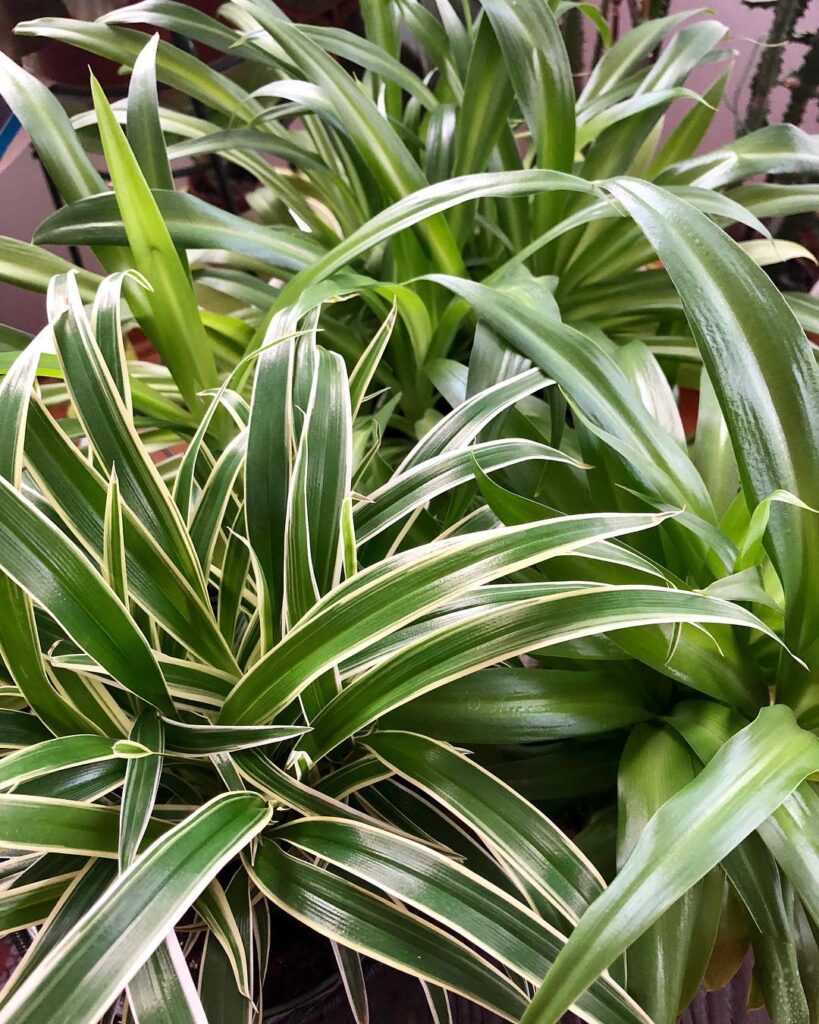
The White-Streaked Spider Plant (Chlorophytum comosum ‘Variegatum’) is a popular houseplant known for its arching leaves with white stripes running along their length. This variety features long, slender leaves that grow from a central rosette, with cream to white variegation along the leaf margins. The plant produces long stems called stolons that bear baby plantlets, creating a cascading effect that makes it particularly attractive in hanging baskets. These plantlets can be easily propagated to create new plants, making it a rewarding choice for both novice and experienced gardeners.
- Light: Bright, indirect light; avoid direct sunlight which can burn leaves; can tolerate lower light conditions but may lose variegation
- Water: Keep soil moderately moist; water when top inch of soil feels dry; reduce watering in winter
- Soil: Well-draining potting mix rich in organic matter
- Humidity: Tolerates average household humidity levels; benefits from occasional misting
- Temperature: Thrives in normal room temperatures between 60-75°F (15-24°C)
- Fertilizer: Feed with balanced liquid fertilizer every 2-4 weeks during growing season
- Container: Use pot with drainage holes; repot when rootbound
15. Green-Speckled Rubber Plant
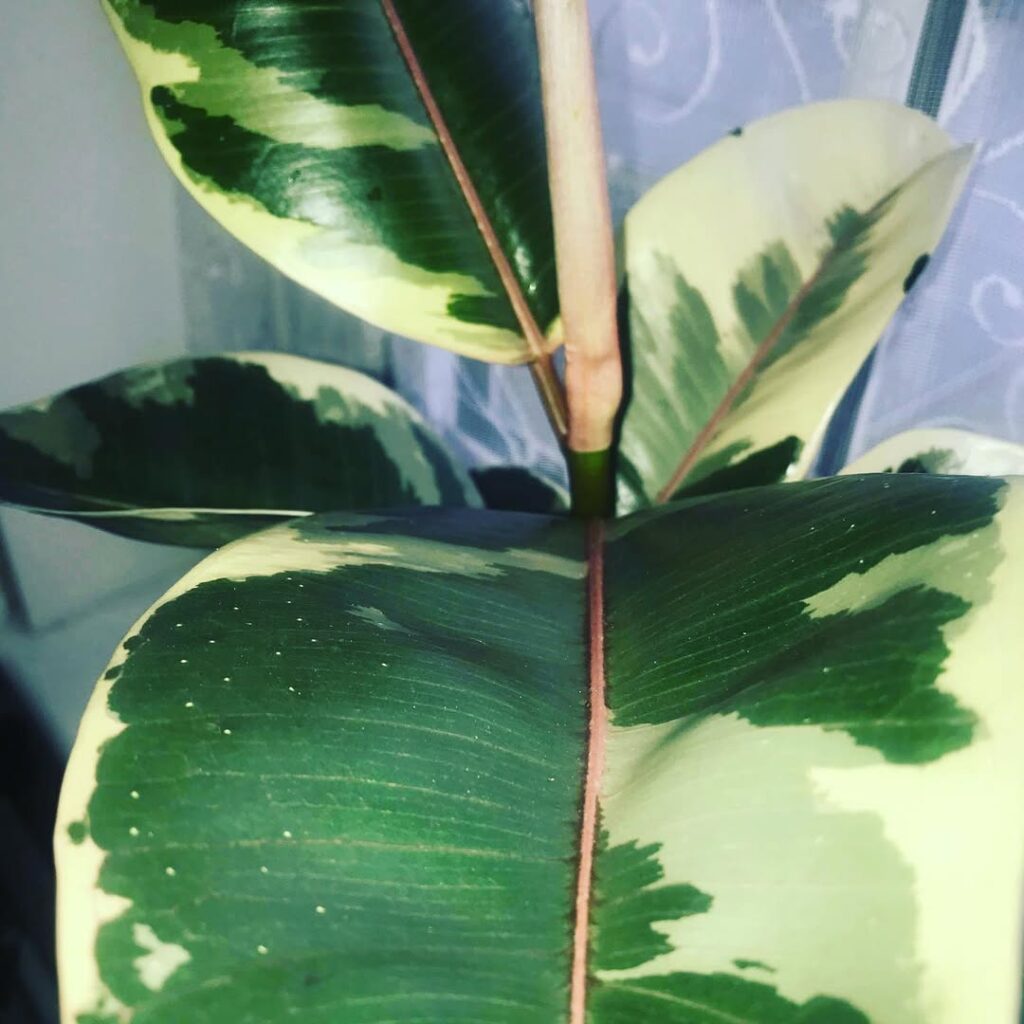
The Green-Speckled Rubber Plant (Ficus elastica ‘Doescheri’) is a striking cultivar of the classic rubber plant, featuring large, leathery leaves with irregular patterns of light green speckles and splotches against a darker green background. This variegated variety grows more slowly than solid-green rubber plants but can still reach impressive heights of 6-8 feet indoors when mature. The distinctive mottled appearance adds visual interest and texture to indoor spaces while maintaining the durability and air-purifying qualities that rubber plants are known for.
- Light: Bright, indirect light; can tolerate some direct morning sun but avoid harsh afternoon sunlight
- Water: Allow top 1-2 inches of soil to dry between waterings; reduce watering in winter
- Soil: Well-draining potting mix rich in organic matter
- Humidity: Moderate to high; benefits from regular misting
- Temperature: 60-80°F (15-27°C)
- Fertilizer: Feed monthly during growing season with balanced liquid fertilizer
- Pruning: Remove damaged leaves and trim to control size as needed
